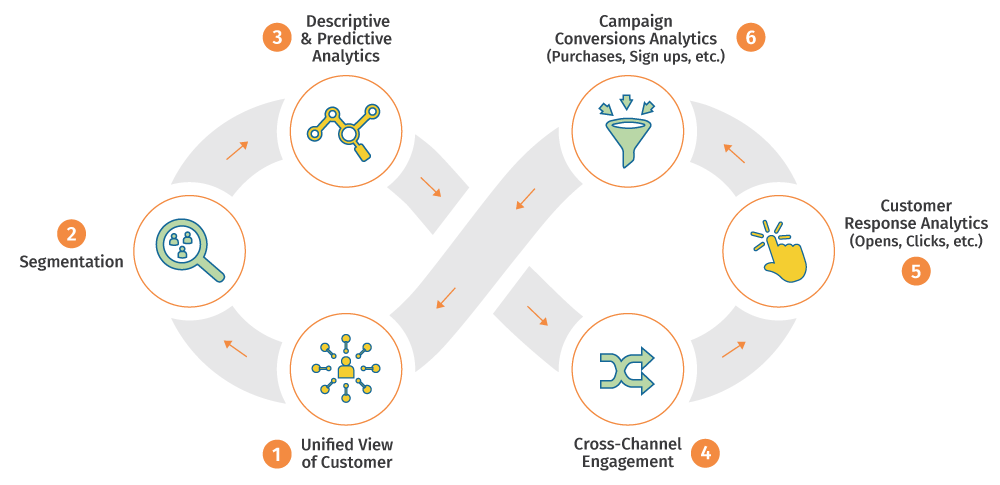To completely understand about marketing analytics and why do we care about it, we must first clear our basics like:
What is Marketing Analytics?
Marketing analytics is a study of process and technology that enable marketers to analyze data and metrics to determine the dynamics of a special market within a special industry and also help in understanding the impact and measure performance based on marketing activities. It uses the important measure to maximize ROI and identify the areas of improvement, overall marketing effectiveness.
 Source: https://urlzs.com/3JSM
Source: https://urlzs.com/3JSM
Why Marketing Analytics?
As businesses expand into a new market, new technologies were adopted to support them. Diverse technologies were implemented across several platforms in order for companies to advertise., market and clear brand awareness. As a marketer, along with your long task list, you need to be conversant with every new marketing medium that is introduced. But how do you know which of your efforts are making a difference? Is the new platform or new technology that you just signed-up for even bringing in any results? Companies need to analyze data from a combination of channels where marketing activity was carried out. This permits them to be sure about campaign performance. But initially, marketers were only checking for data and deciding about campaign success. You can’t rely on guesswork or gut feeling to be successful in this era of marketing. You need to back up the feasibility of every activity with facts and figures. It helps you understand which marketing activities are bringing in revenue. Marketing Analytics eliminated this roadblock by facilitating data scrutiny across all channels. Stakeholders now had enhanced clarity about product performance. Marketing Analytics was revolutionary in changing the Marketing dynamic.
Steps of marketing analytics success
1. Find your objective and create strategy:
Before the marketing analytics, the company should design a Bright strategy based on the company objectives. Several tools are available in the digital marketplace that allows companies to construct tailor-made campaigns which revolve around their product and help them find their company objectives in the market.
These tools center around search engine audience sentiment about popular keywords, trends, popular hashtags among many others. By building a campaign that includes these words marketers can place their bets for a campaign victory.
The strategy is the key and depending on brand perception, platforms that resonate the product should be engaged in the campaign. Once the campaign is launched, back-end analytic tools come into the picture. These tools will allow marketers to check for various aspects that encapsulate the digital marketing spectrum like conversions, incoming leads, website traffic, etc.
2. Determine a data model:
Vast amounts of data get generated during the campaigning process which can be converted into meaningful insights. Marketers need to ensure that they have covered and collated data elements getting generated from all the sources which were involved in a marketing campaign. The data generated would be unstructured.
A model consists of columns in a spreadsheet and calculation used to give you results or metrics. This is the perfect time to understand what data you have to work with and to possibly bring in an experienced analyst to assist with questions. You may have more to work with than you initially thought, so it’s best to lay it all out.
This data can later be structured by the use of several tools to get transparency about how customers are shopping today. With an increasing number of people buying products on their mobile phones, entrepreneurs are trying to make shopping as rapid as possible for this group of buyers. Omnichannel e-commerce platforms are also the rage.
3. The Scope of marketing analytics:
Just like data analysis can give specific insights, the overall scope of Marketing Analytics can be put in a nutshell by these functions.
Assessing marketing campaigns: Marketing Analytics tools provide precise information about campaign performance along with determining areas of improvement if any and predicting how they would perform in the future.
Competitor assessment: Tools help to understand if the competitor campaign is doing better and why it is doing better. It helps to understand what competitors are doing right and if they are using certain channels that might garner more campaign success.
Assessing the company that has initiated the marketing campaign: Finally, it allows you, the campaign originator to reflect as an organization if the marketing resource allocation is appropriate or not. It also helps in understanding the next steps that need to be taken allowing to reshuffle priorities. Lastly, it helps to understand if money and time are being immersed in the right marketing mediums.
4. Use a balanced assortment of analytics techniques:
To get the most benefit from marketing analytics, you need an analytic assortment that is balanced – that is, one that combines techniques for:
Reporting on the past. By using marketing analytics to report on the past, you can answer such questions as Which campaign elements generated the most revenue last quarter? How did an email campaign A perform against direct mail campaign B? How many leads did we generate from blog post C versus social media campaign D?
Analyzing the present. Marketing analytics enables you to determine how your marketing initiatives are performing right now by answering questions like: How are our customers engaging with us? Which channels do our most profitable customers prefer? Who is talking about our brand on social media sites, and what are they saying?
Predicting and/or influencing the future. Marketing analytics can also deliver data-driven predictions that you can use to influence the future by answering such questions as: How can we turn short-term wins into loyalty and ongoing engagement? How will adding 10 more sales people in under-performing regions affect revenue? Which cities should we target next using our current portfolio?
5. Create actionable reporting and fill in the gaps:
Marketing organizations have access to a lot of different analytic capabilities in support of various marketing goals, but if you’re like most, you probably don’t have all your bases covered. Assessing your current analytic capabilities is a good next step. After all, it’s important to know where you stand along the analytic spectrum, so you can identify where the gaps are and start developing a strategy for filling them in.
For example, a marketing organization may already be collecting data from online and POS transactions, but what about all the unstructured information from social media sources or call-center logs? Such sources are a gold mine of information, and the technology for converting unstructured data into actual insights that marketers can use exists today. As such, a marketing organization may choose to plan and budget for adding analytic capabilities that can fill that particular gap. Of course, if you’re not quite sure where to start, well, that’s easy. Start where your needs are greatest, and fill in the gaps over time as new needs arise.
6. Apply Learning and validate:
There is absolutely no real value in all the information marketing analytics can give you – unless you act on it. In a constant process of testing and learning, marketing analytics enables you to improve your overall marketing program performance by, for example: Identifying channel deficiencies. Adjusting strategies and tactics as needed. Optimizing processes. Gaining customer insight.
Without the ability to test and evaluate the success of your marketing programs, you would have no idea what was working and what wasn’t, when or if things needed to change, or how. By the same token, if you use marketing analytics to evaluate success, but you do nothing with that insight, then what is the point?
Applied holistically, marketing analytics allows for better, more successful marketing by enabling you to close the loop as it relates to your marketing efforts and investments. For example, marketing analytics can lead to better supply and demand planning, price optimization, as well as robust lead nurturing and management, all of which leads to more revenue and greater profitability. By more effectively managing leads and being able to tie those leads to sales – which is known as closed-loop marketing analytics – you can see which specific marketing initiatives are contributing to your bottom line.
Conclusion
In the realm of marketing, primary research has traditionally focused on quantitative or qualitative methodologies to provide customer insights. With advances in technology, especially data mining, marketing analytics has become an invaluable tool and should be viewed as an equal component of the marketing research toolkit. Analytics requires marketers to use data to understand customers at every touch point throughout their lifecycle with the business. To do this the analyst must mine, analyze, interpret, and present the information so that it is converted into actionable intelligence. In this process, the customer’s information DNA is tracked, segmented, modeled and then acted upon. As these concepts and tools become standard operating procedures, marketing departments must internalize analytics into their overall curriculum in order to provide Company with a compelling competitive advantage.














